Dog Gait or Movement Terminology
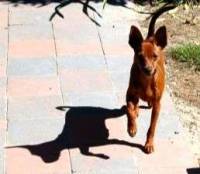 Miniature Pinscher
Miniature Pinscher
Gait or movement is the crucial test of conformation. This section begins with normal movement and then describes moving in different ways. Some gaits are exaggerations of the normal like the Miniature Pinscher with its hackney gait, the Old English Sheepdog with its amble or pace and the Afghan Hound with its style of high order. Additionally some breeds, especially those with aSighthound construction are capable of a double suspension gallop.
Trot with balanced Reach and Drive
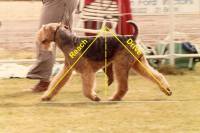 Airedale Terrier
Airedale Terrier
Both these dogs are moving at a balanced trot. The forward movement of the front legs is called 'reach' and the backwards movement of the hind legs is called 'drive'. Correctly balanced movement is when the reach of the front legs equals the drive of the back legs and the back or topline remains firm and level.
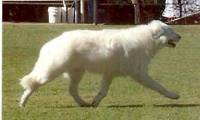 Maremma Sheepdog
Maremma Sheepdog
Note the carriage of the head and tail of the Airedale Terrier is higher than the working breed, the Maremma Sheepdog. So thelength of stride of the Maremma is longer that of the Airedale and the sheepdog covers more ground with each stride than the terrier.
Hackney Gait
 Hackney Horse
Hackney Horse
The name hackney gait derives its name from the hackney horse. At a trot, this hackney gait is an exaggerated high knee and hock action due to very good flexion of the joints. This action should be straight and true with a distinct pause or moment of suspension at the top of each stride. The front legs should reach up high with sharply bent knees that are stretched well forward with a ground covering stride.
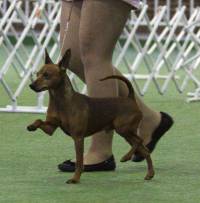 Miniature Pinscher
Miniature Pinscher
Combine this with a similar high stepping action of the hind legs that are well propelled underneath the dog with a similar exaggeration, we have the hackney gait. Whilst correct for aMiniature Pinscher, it is incorrect when seen in most other breeds.
Pace or Amble
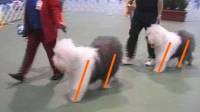 Old English Sheepdogs
Old English Sheepdogs
A Pace or Amble is when two legs on one side move together and then the two legs on the other side move together. This is in contrast to legs on the same side moving in opposite directions as shown by the balanced reach and drive of the Airedale and Afghan Hound above.
While this gait is typical of the Old English Sheepdog pictured here, it is incorrect gait for the show ring in other breeds.
Double Suspension Gallop
This is typical of Sight Hounds like the Deerhound pictured. At full gallop we can see on the left how the front legs extend between the back legs when the dog is in full stride and then reach out again as the picture on the right demonstrates. This action produces a series of gigantic leaps during which the dog becomes totally air borne.
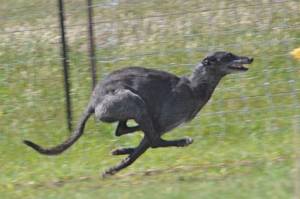 Deerhound
Deerhound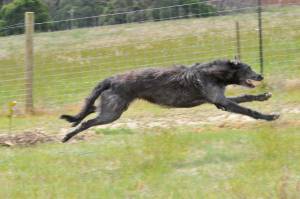 Deerhound
DeerhoundThe Unique Gait of the Afghan Hound
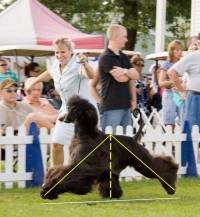 Afghan Hound
Afghan Hound
The Afghan Hound has a unique specialized gait described in its Breed Standard as 'smooth and springy with a style of high order'. The Afghan's typical effortless, graceful but unique gait is correctly achieved by the exaggeration of these three components:
- Longer bones with more muscle strength in both front and rear assemblies relative to its body weight compared to that of a normally built dog, giving the hound power to have definite spring in its gait.
- Greater reach and drive in both the front and rear assemblies than is shown for 'balanced reach and drive' in the example of the Airedale above. This requires greater flexibility in the pastern which acts as a shock adsorber to cushion the greater reach and drive as well as the spring. When combined with an equivalent flexibility in the hock joint and length from hip to hock, the hound is able to move gracefully and smoothly.
- Higher head and tail carriage compared to a normally built dog, giving the Afghan its proud carriage or style of high order.
This unique combination produces the co-ordinated smooth and springy gait with the style of high order so admired in an Afghan Hound.
https://janedogs.com/dog-gait-or-movement-terminology/